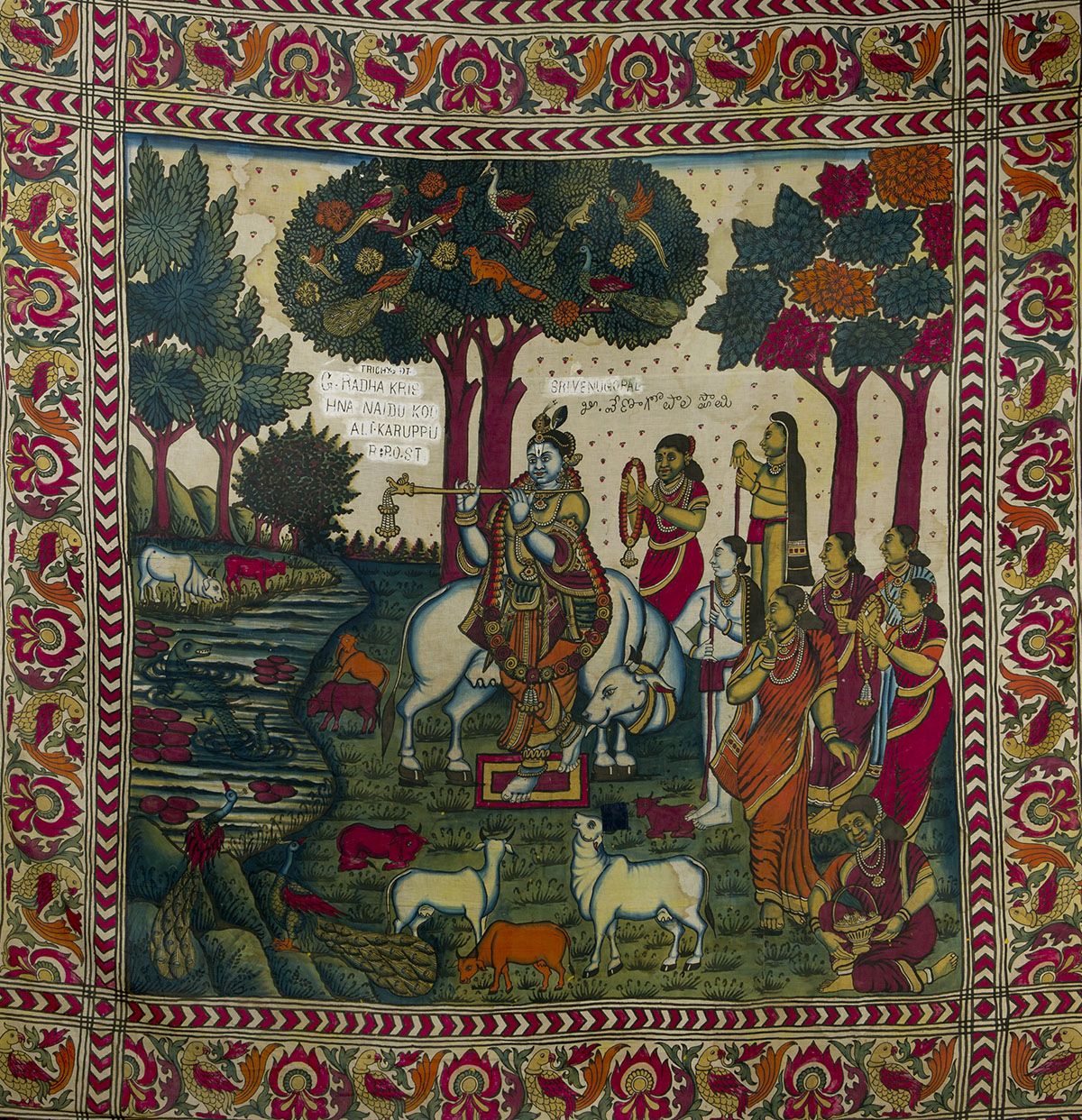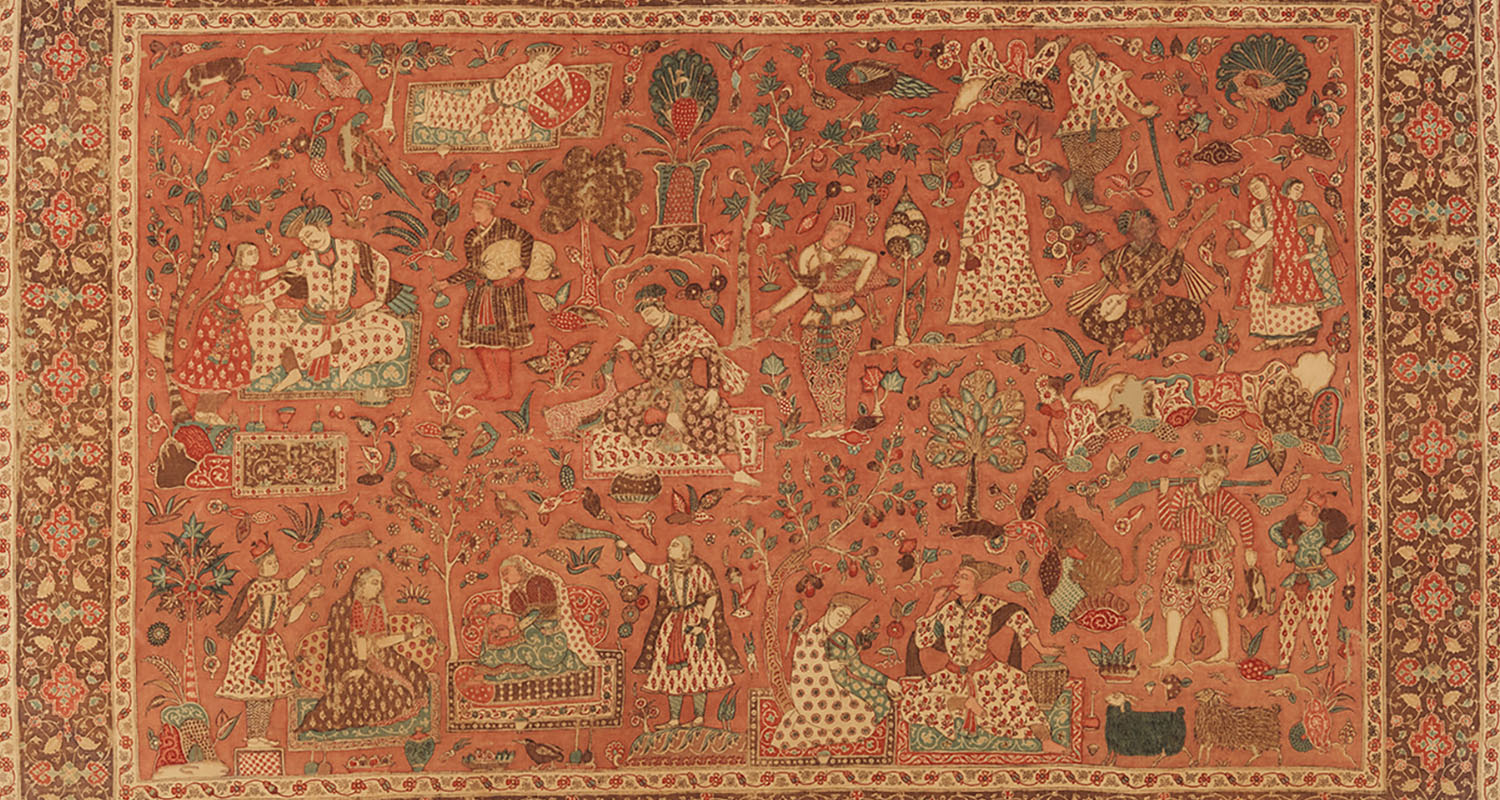ARTICLE
Kalamkari
A textile tradition where cotton textiles are traditionally hand-painted with pictorial narratives through a bamboo pen known as kalam, kalamkari emerged across the Coromandel coast in southern India and the state of Andhra Pradesh has long been considered its focal centre. Concentrated largely around the town of Srikalahasti, kalamkari’s other major centres of production include Machilipatnam (formerly Masulipatnam) and Madurai. It was originally referred to as vraata pani, which stands for writing (vraata) work (pani) in Telugu and during the reign of the Qutub Shahi dynasty in the sixteenth century, it was renamed kalamkari. While the exact point of origin for kalamkari remains unknown, the oldest surviving samples of the craft are dated from the fifteenth and sixteenth centuries. These samples were made as trade fabrics, to be exported to Southeast Asia, implying that kalamkari must have enjoyed sustained popularity in the region, pre-dating these samples.
Kalamkari consists of twenty-three steps including treating the fabric by bleaching it and then softening it; sun-drying; preparing natural dyes; hand-painting; air drying; washing; and finishing. Commonly, cotton is used which is then treated with a solution of cow dung and bleach casting the fabric in an off-white colour. This is followed by the immersion of fabric in a mixture of buffalo milk and myrobalans so that it absorbs and retains the colour of dyes and paints without smudging. The fabric is then rinsed twenty times and dried under the sun before it gets ready to be painted over. When ready for painting, the artists sketch out their drawings and later fill them in with colours. Kalamkari features drawings rendered with a strong black outline and the use of naturally extracted colours; black was made by mixing jaggery and iron filings with water, red from the bark of madder or alizarin, blue from indigo, mustard by boiling pomegranate peels and green by combining yellow and blue colours.
The painted kalamkari textiles were initially associated with temple worship as they were used as visual companions in both religious and secular contexts; they were used as hangings and canopies commissioned by Hindu temples, monasteries (maths) and by individuals. For the markets and court, kalamakari was used to produce textiles with secular narratives. The layout of the textiles was largely influenced by local traditions of mural painting as well as architectural forms such as lobed arches and pillars, trees and shrubs, which were used as framing devices. Themes depicted in the textile included scenes from Puranas and epics such as Mahabharata and Ramayana, with the latter enjoying a notable popularity. Other scenic depictions common to kalamkari were sacred sites of the region, such as the Kallalagar temple, Alagar Koyil and the Sriranganatha temple, Srirangam island. Additionally, Telugu epics, such as Katamaraju Katha, as well as biblical themes, were illustrated.
The major centres of kalamkari production have their own thematic and stylistic peculiarities. In Machilipatnam, kalamkari was used to produce canopies with mythological scenes for Hindu clients, prayer carpets for Muslims, tentage with floral designs for the royal courts, as well as yardage of chintz to be imported to the European markets. From the middle of the nineteenth century, the city saw a flourishing printing and dyeing industry which dwindled in the twentieth century. Madurai was particularly famous for its fine red dye, which had a distinctly deep colour. The kalamkari here was produced on coarse cloth that was stained and dyed in only two colours – red and black. At Srikalahasti, which is a temple town located close to Tirupati, the craft practice remains active to date and it is probable that the history of kalamkari work in the city dates further back than the fifteenth–sixteenth century, but due to the corrosive nature of the textile and lack of written records, there are no ways to qualify the claim. The local zamindars (landlords) patronised the craft, most of which was carried out to make temple cloth. By the 1930s and 40s, with the independence of India and ousting of the zamindari system, the patronage tapered off. However, it was revived by the All India Handicrafts Board, which inaugurated a production-cum-training centre at Panagal, on the outskirts of Srikalahasti. The Weavers’ Service Centre also promoted and offered commissions and training to the artisans.
Presently, kalamkari is predominantly secular in nature and caters to Indian and foreign markets with fabric for apparel and home linens such as curtains and bedspreads. In catering to these markets, the textile has witnessed a transformation, one that began with the trading textiles from Machilipatnam to European and Southeast Asian markets itself, wherein floral motifs were integrated instead of pictorial narratives and block-printing was employed for faster production becoming integral to kalamkari products especially when mass-produced. In 2006, Srikalahasti kalamkari registered a Geographical Indication (GI) tag, and Machilipatnam kalamkari did so in 2009.
Bibliography
Our website is currently undergoing maintenance and re-design, due to which we have had to take down some of our bibliographies. While these will be re-published shortly, you can request references for specific articles by writing to hellomapacademy@map-india.org.









